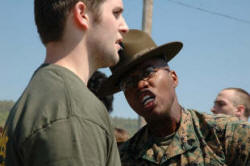Teacher talk
 |
|
I'm foreign, not deaf. |
This guide is about your language and your voice – the most important language input your learners get (probably).
 |
The teacher-talking-time myth |
If you are taking or have just taken an initial training course, you will probably have encountered one of English Language Teaching's most durable mythologies:
Teacher Talking Time is always bad.
Even on in-service training courses such as the Cambridge Delta
or Trinity Diploma, the myth endures in one form or another and
trainees are constantly told to reduce their teacher talk (TTT) to a
minimum.
It is undeniable that the more a teacher talks, the less opportunity
there is for learners to talk but the reasoning behind the assertion
usually stops there and assumes:
- all teacher talk is the same
- learners learn best by talking
Some teacher talk is poor and it may be vague, disjointed,
space-filling chit-chat or lecturing about something the learners
should be finding out for themselves. It may also be
long-winded explanation and instruction giving which is difficult to
penetrate for meaning. That is bad teacher talk.
Some learners probably do learn as they talk and the pressure to
communicate ideas is a compelling factor in encouraging people to
upgrade their language skills and practise what they already know.
To assert, however, that all learners learn best when they are
obliged to talk regardless of what they are learning, their
cultural backgrounds and personal preferences is, frankly, nonsense.
Many people also learn by listening, thinking, noticing what others
say and reading.
Here, we are not concerned with the quantity of teacher talk (that's TTT or Teacher Talking Time), we are concerned with its quality (i.e., TTQ).
 |
Three reasons to speak |
Teachers speak in the classroom for three main purposes.
- To manage the learners and the classroom.
- To teach (not necessarily to tell) and model.
-
To maintain relationships between the teacher and the
learners and between the learners.
Often this is a question of maintaining engagement and motivation.
 |
Task 1:
Here are 12 examples of things that teachers say in the
classroom. Categorise them into three lists (as above) and then check here. |
- John, please sit here with Mary. Thank you.
- Now, hate is a regular verb so the past tense is ...
- OK. Listen again and choose the right answers.
- Why are you so late?
- Please try to help each other with this.
- That was excellent. Well done!
- You will present the findings of your survey to the whole class.
- I had a terrible day yesterday, listen while I tell you about it.
- Now, are you going to work alone or in pairs?
- No, that's not quite right. What time are we talking about?
- You spell that with two m's
- Good morning. How are we all today? Ready to do a little work? Great!
Here is the list again with some comments on what is going on.
| Utterance | Purpose(s) |
| John, please sit here with Mary. Thank you. | Management: but being courteous also helps maintain good relationships. |
| Now, hate is a regular verb so the past tense is ... | Teaching: supplying some information and asking the learner to deduce the right answer. |
| OK. Listen again and choose the right answers. | Management: instructing |
| Why are you so late? | Maintaining relationships and
Teaching: a complaint is part of maintaining discipline but it's also an opportunity to allow the learner to practise giving an excuse. |
| Please try to help each other with this. | Management: but with an element of social maintenance in encouraging cooperation. |
| That was excellent. Well done! | Management and Maintaining
relationships: by signalling the end of a phase of the lesson, giving feedback and maintaining motivation. |
| You will present the findings of your survey to the whole class. | Management: but telling students why they are doing something and what comes next also enhances motivation. |
| I had a terrible day yesterday, listen while I tell you about it. | Teaching: using her own story as language input. This also maintains relationships because a story about someone you know is usually more interesting than stories about imaginary or unknown people. |
| Now, are you going to work alone or in pairs? | Management: instruction checking. |
| No, that's not quite right. What time are we talking about? | Teaching: supporting the learner's efforts by leading him to the right form. |
| You spell that with two m's | Teaching: informing. |
| Good morning. How are we all today? Ready to do a little work? Great! | Maintaining relationships: motivating through being enthusiastic. |
 |
Good teacher talk is ...
|
The word CLEAR is a mnemonic to help you remember the characteristics of good lesson aims (Clear, Limited, Explicit, Achievable, Relevant). You can use the same trick here and the categories are also almost the same.
Good teacher talk is:
| Clear | not mumbled, spoken facing the board or spoken too quickly. |
| Limited | Too much teacher talk is often criticised and it is true that the more the teacher talks, the less the students can say. However, the quality of teacher talk is what is really critical. Limiting teacher talk usually leads it to being precise and understandable. |
| Explicit | Learners need to be aware of the teacher's intentions.
If a learner is thinking (or saying): Is this an instruction, some information or just a chat? then the teacher talk has not been explicit. Developing tones to make intention clear is a key skill so that your learners become accustomed to recognising your intention by the tone of your voice. Another skill is not mixing intentions in the same utterance. Don't say: That's really good, isn't it but you need to write it on the board and correct the spelling problem because that mixes social talk with instruction with teaching and is very confusing. Prefer then: Good! [Pause for student response] Check the spelling of this word, please. [Pause for student response] Now go and write it on the board, please. |
| Appropriate | Teacher talk to should tell learners what they need to know and no more. You may know, e.g., that something is an example of an ungradable adjective but your learners may not want or need to be burdened with this knowledge right now because it has nothing to do with the lesson focus. |
| Relevant | This just means maintaining your focus and not using teacher talk to fill silences or go off on tangents. |
 |
Teaching talk |
When we are teaching, we need
to be CLEAR and unambiguous and keep things short.
When it comes to language teaching, lecturing rarely helps.
 |
Task 2:
Think about what kinds of function teachers express when
they are teaching. Click here when you have thought of two. |
- Explaining and informing
- Teachers explain and inform:
When they are presenting new data:
this verb is irregular
the stress falls on the first syllable
this verb is ditransitive and the objects can come in two orders: indirect plus direct or direct + to + indirect, like this [board writing]
When they respond to questions:
Yes, good question. The reason is that the modal auxiliary verb has two functions (at least) and they are ...
When they focus on meaning:
this means the same but is more formal
it is a tool we use to make holes in the garden
it is a very positive adjective for people who work hard
etc. - Eliciting
- Whole class:
Now, can anyone tell me what was said about this man's flight to Rome?
Individual nominations:
Is that right, John?
What do you think, Mary?
NOTE: individual nominations should usually come after the question. That way, everyone's listening because nobody knows who has to answer.
Group nominations:
Now, let's see what we have.
This group here first. What do you think?
We can elicit both information and action from students:
Information:
Where's the stress on this word?
Action:
Can you repeat that with the stress on the new information?
- Giving feedback
- As information:
That's mostly right but you need a preposition here.
As evaluation:
Well done. That was really good.
As a preface to elicitation:
Yes, OK. Why is that the right answer?
 |
Using the learner's first language |
There are those who will tell you that we should avoid the use of the learners' first language where possible. We want to establish an English-only environment because:
- With some classes it just isn't possible to do anything else. Some classes have a mix of first languages and you are unlikely to know them all. Having a group who mostly but not all speak a particular language is sometimes challenging because the majority can exclude the minority.
- We want people to start thinking and interacting in English even when they are only using the language for social purposes in the classroom.
- We do not want to encourage people to translate everything
into their first language(s) because:
- it slows down the speaking, reading and listening processes in particular
- translation between languages is
rarely precise because words cover different concepts and
may be used in different styles, like this:

with only the area represented by the green colour being common to both languages.
The reason for this is that words occupy different semantic spaces in different language. For example, the words cup, mug and glass are clearly differentiated in English but in other languages (such as Spanish, German and French) only two words cover all three ideas with no differentiation between cup and mug. Other languages, such as Turkish, may differentiate between mug and the other two nouns but use the same word for cup and glass. Others again, may have three words or even only one for all three objects. - translation is a specialist skill and not one that most of our learners will need.
However ...
 |
Task 3:
There are times when using the learners' first language(s),
if you know them or it, can be very helpful. Think about when and why you might use the learners' first language(s) in a classroom? Click here when you have thought of something. |
- For safety reasons
- You do not want a learner to misunderstand
Don't touch that! It's very hot. - For counselling and pastoral care reasons
- Especially with younger learners, you need to be able to respond to social problems sensitively and helpfully. That is often best done in the learner's first language.
- With very elementary groups
- The sooner you can teach the chunks for the language functions people need, the better (there is a guide, linked below, to identifying learners' language which covers this point more thoroughly). However, at the outset of learning, it is often quicker and more efficient to give instructions and some explanations in the learners' first language.
- With abstract concepts or unusual words
- A concept such as a cosy relationship is actually
very difficult to define in other English words so recourse to
translation is an option.
Unusual words, for example, for some types of machines or animals, may only be needed for a few minutes to understand a text and it is not worth spending time trying to draw pictures of things like ferret (it is one of these):
 )
) - When comparing languages
- Learners' first languages are often seen as a source of
error but they are also a resource for learning.
For example, related languages will often have similar structures. Drawing learner's' attention to the fact can be a useful shortcut.
Related languages will also have cognate words (words which come from the same source) and, while some will carry different meanings, most will be the same. That's another useful shortcut to meaning.
It is often useful to know how our first language differs from a language we are learning so we can be alert to the differences and avoid errors caused by word-for-word translation.
 |
Instructional language |
Here's a (real) example of management talk in a classroom:
Err, Jaime, no, I don't mean that. Pedro, yes, Pedro, can you ... err ... please come and .. um ... sit here with ... err Maria, isn't it? Yes, that's right ... now ... Helena and Miguel ... what I'd like you to do is, perhaps, yes, one of you come and join Jaime. Oh, yes, bring a pen and paper with you. Pedro: do you have a pen? No? Oh, would you like to go and get one then, please. Right now ... OK?
 |
Task 4:
Think about what is wrong with that instruction, what the
teacher should have said and why it happened. Click here when you have two problems and the probable reason. |
- The instruction is too wordy and confusing. There are
three long sentences and the teacher uses
Can you ...
What I'd like you to do is ...
and
Would you like to ...
It would be much better, especially with lower-level learners to use a simple imperative with or without the word please:
Pedro. Bring a pen and paper and sit here with Maria, please.
Helena and Miguel. Bring a pen and paper and sit with Jaime. - There are lots of unnecessary words such as perhaps, yes, here, that's right, now, Oh, then etc. At lower levels especially, this just adds complications and makes comprehension very difficult.
- The teacher stops and restarts, repairing what he wants to say. He needs to get it right in his own head before he starts talking.
- The instruction is ambiguous: does the teacher want Helena or Miguel to sit with Jaime? Learners are often intolerant of ambiguity.
- All of this went wrong because of two factors, probably:
- The teacher has not prepared what to say even by pausing for a second or two to think it through.
- The teacher mistakenly believes that complex and very polite instructions will help form relationships. They do not because learners expect teachers to assert themselves and imperatives with the right intonation are just as polite and sensitive.
- The morals of the story:
- Prepare instructions.
- Keep them short.
- Make them unambiguous.
 |
Getting things in the right order |
Instructions need to be carefully ordered. Repairing means going back to the beginning and explaining again what should have been clear the first time.
If learners are to get on with learning, they need to know exactly what it they have to do. All of them need to know, all of the time.
 |
Task 5:
Here are the parts of an instruction sequence. Put them in the right order and then check here. |
- Repairing if necessary
- Getting everyone's attention
- Stating the purpose of the activity or task
- Stopping the previous activity or task
- Giving the necessary instruction to start the task or activity
- Stopping the new task or activity
- Requiring feedback
- Getting everyone's attention
- This must come first or you are talking to yourself and much time will be wasted later. Many teachers use a routine for this which their learners recognise. Loud hand claps or a bell to ring are effective.
- Stopping the previous activity or task
- Don't let people carry on with something that is finished.
This means framing the stages of the lesson with something like:
Right! Good. Well done. Now ... - Stating the purpose of the activity or task
- This comes before the instruction. Tell people why
they are moving on. For example:
Now we need to look at the pronunciation.
OK. Now you have the form right, let's put it into action.
etc.
Stating the purpose of activities maintains a sense of development and progress. - Giving the necessary instruction to start the task or activity
- Note the word necessary in that. If the activity or task is quite complicated, the instruction needs breaking down into sections and so does the task. Complex tasks often need to be demonstrated, too.
- Stopping the new task or activity
- This is just like the first step. You need everyone to stop at the end. Try to finish an activity a few seconds before it naturally stops.
- Requiring feedback
- Even if the process of doing a task is more important than its outcome, some feedback is always needed. It may be unimportant what ideas the class have had in a brainstorming activity, for example, but the ideas need to be valued in some way. Other tasks, in which the product is important need more thorough feedback.
The first one in the list above was to do with Repairing. This can come at any stage and you need to stay alert to the need to do it.
 |
Sequencing teaching talk |
So far, we have identified three sorts of teaching talk:
- Explaining
- Eliciting
- Giving feedback
 |
Task 6: How should these be linked and sequenced? Think about the question and then click here. |
- Explaining:
- First: say what you are explaining or
you won't have focus. For example:
The modal auxiliary verb should is used when you want to say what you have logically understood. For example [board] He should be there by now. He left hours ago! means, Logically, I know that it is not a long journey so I think he is there. - Second: concept check with another example. For
example:
Look at these sentences: He should be at home by now. He finished work an hour ago.
What does should mean here? Am I giving advice? Am I thinking logically?
- First: say what you are explaining or
you won't have focus. For example:
- Eliciting:
- Nominate first: for example, by name, by looking at someone, by groups, the whole class. Learners need to know who should be contributing.
- Or nominate second: if you ask the question before you nominate, nobody knows who will be called on so everyone has to think about the response.
- Second: ask your question or state your requirement.
For example:
John, is she thinking about where he must be or is she giving him some advice?
This group: What ideas do you have for the first question?
- Giving feedback:
- First: stop the class or the learner and get attention.
- Second: give an overall evaluation such as:
That's good. Well done. - Third: decide if you are giving or getting feedback.
If you are getting feedback, elicit as above.
If you are giving feedback, make it clear and to the point, not general and vague.
 |
Self-test questions |
Try these questions to judge whether you have understood this guide.
- What does CLEAR stand for?
- Give two characteristics of good teacher talk.
- Explain the difference between informing and eliciting.
- Explain what 'repairing' means in this context.
- Give a reason why it is important to frame lesson stages clearly.
- Why is nomination helpful?
| Related guides | |
| teacher roles | for the guide to the many roles a teacher may need to adopt |
| grouping learners | for a guide which considers how best to arrange the learners to fit the activity stage in the lesson |
| learner talk | for a guide to the other side of the equation: the learners' language |
| asking good questions | questioning is a key teaching skill but there's a bit more to it than just asking for information |
| being clear | for some advice about getting your message across clearly, simply and unambiguously |
